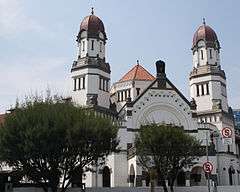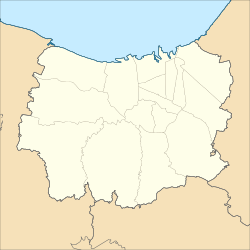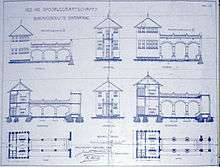Lawang Sewu
Lawang Sewu ("Thousand Doors") is a landmark in Semarang, Central Java, Indonesia, built as the headquarters of the Dutch East Indies Railway Company. The colonial era building is famous as a haunted house and filming location, though the Semarang city government has attempted to rebrand it.
| Lawang Sewu | |
|---|---|
 Lawang Sewu in 2011 | |
 Location in Semarang | |
| Former names | Administratiegebouw Nederlands-Indische Spoorweg Maatschappij |
| General information | |
| Address | Pemuda Street |
| Town or city | Semarang |
| Country | Indonesia |
| Coordinates | 6°59′2.13″S 110°24′38.28″E |
| Groundbreaking | 1904 |
| Completed | 1919 |
| Opened | 1907 |
| Owner | Indonesian Railways |
| Technical details | |
| Floor count | 3 |
| Design and construction | |
| Architect | C. Citroen |
| Architecture firm | J.F. Klinkhamer and B.J. Quendag |
Etymology
The name Lawang Sewu is from Javanese; it means "Thousand Doors".[1] The name comes from its design, with numerous doors and arcs.[2] The building has about 600 large windows.[3]
Layout

The complex consists of several buildings, two main ones named A and B and two smaller ones named C and D, on Pemuda Street.[4][2] The l-shaped A building faces the Tugu Muda roundabout.[4][2] There are two identical towers on A building, which were originally used to store water, each with a capacity of 7,000 litres (1,800 US gal).[4] The building features large stained-glass windows and a grand staircase in the center.[5] There was also once a tunnel connecting A building to several other sites in the city, including the governor's mansion and the harbour.[4]
The B building is located behind A building.[4] It is three stories in height, with the first two floors consisting of offices and the third holding a ballroom.[4] The building, with high, large windows, also has a basement floor that is kept partially flooded to serve to cool the building through evaporation.[4]
In front of A building stands a monument to five employees killed during the Indonesian War of Independence.[6]
History
_in_Semarang_TMnr_10032316.jpg)

Lawang Sewu was designed by Cosman Citroen, from the firm of J.F. Klinkhamer and B.J. Quendag.[2] It was designed in New Indies Style, an academically-accepted term for Dutch Rationalism in the Indies.[7] Similar with Dutch Rationalism, the style is the result of the attempt to develop new solutions to integrate traditional precedents (classicism) with new technological possibilities. It can be described as a transitional style between Traditionalists and the Modernists, and was strongly influenced by the design of Berlage.[8]
Construction began in 1904 with A building, which was completed in 1907.[4] The rest of the complex was finished in 1919.[4] It was initially used by the Nederlandsch-Indische Spoorweg Maatschappij, the first railway company in the Dutch East Indies.[4]
After the Japanese invaded Indonesia in 1942, the Japanese army took over Lawang Sewu.[4] The basement of B building was turned into a prison, with several executions taking place there.[4] When Semarang was retaken by the Dutch in the battle of Semarang in October 1945, the Dutch forces used the tunnel leading into A building to sneak into the city.[4] A battle ensued, with numerous Indonesian fighters dying.[2] Five employees working there were also killed.[6]
After the war, the Indonesian army took over the complex.[6] It was later returned to the national railway company.[6] In 1992 it was declared a Cultural Property of Indonesia.[3]
By 2009 the Lawang Sewu complex was in a state of considerable dilapidation.[5] Simon Marcus Gower, writing in The Jakarta Post, noted it as being "dark and evidently sick. Its white walls are faded throughout; blackened by pollution and neglect. Rendered walls are cracked and any wall paper has long since fallen away to reveal the red bricks beneath. Mould and weeds grow over much of the building and mice and rats are the chief residents."[5]
The building soon underwent renovations to ensure that it would be profitable as a tourist attraction.[1][9] Governor of Central Java Bibit Waluyo mobilized several dozen soldiers to assist with the renovations; the soldiers focused on external repairs.[1] Local residents were disappointed in the renovations, opining that it had lost its authenticity.[9]
On 5 July 2011 the newly renovated complex was inaugurated by First Lady Ani Yudhoyono.[1] However, at the time only B building was available for tours.[4] It is hoped to be a main attraction in the Central Javan government's tourism program in 2013.[1]
Future plans include transforming Building B into office space, a food court, and even a gym.[10] In late 2013 the Semarang city government announced plans to eliminate the building's "spooky image" in order to attract more visitors. This was to encompass a reimagining of the site as a place for social and cultural activities, supported by renovations of the building. At the time, Lawang Sewu attracted an average of 1,000 visitors daily.[3]
Urban legend
Many centuries where people stood this place as a building, the Lawang sewu is a notorious for beheadings, execution and suicide. The building itself has the background of sinister where it is to be haunted eith many tourists visiting to see the ghosts. The popular building was turn into a haunted attraction and historical sense, in the place looks good for the ambiance of 2007 Indonesian horror film series. Among the ghosts who inhabit the establishment are a young dutch woman who it is reports of suicide.
In 2007, a horror film entitled Lawang Sewu: Dendam Kuntilanak (Lawang Sewu: Kuntilanak's Vengeance) was released based on the legend.[11] It told the story of a group of high school students from Jakarta who were trapped in Lawang Sewu after several had to urinate and featured ghosts of a Dutchwoman, a man with a ball and chain wrapped around his leg,
The building foundation was built for the Dutch where the building's tunnel has connecting sewer lines dark tunnels and dark passageways. Some how it is said to be abandoned construction and a mineshaft. consisting of the two hotspot for active paranormal areas during the Japanese revolution.
some people claimed that they experience odd occurrences in the building itself, hot and cold spots, dark figures and often an apparition slightly more difficult to see.
References
- Footnotes
- Ariwibowo 2011, First Lady Inaugurates.
- Semarang City Government, Lawang Sewu.
- Rohmah 2013, Lawang Sewu.
- Prihadi 2011, Lawang Sewu Kini.
- Gower 2009, Lawang Sewu: Ahaunted.
- Tio 2011, p. 62.
- Gunawan Tjahjono, ed. (1998). Architecture. Indonesian Heritage. 6. Singapore: Archipelago Press. p. 120. ISBN 981-3018-30-5.
- "Rationalisme, Traditionalisme, Americanisme". Het Indische bouwen: architectuur en stedebouw in Indonesie : Dutch and Indisch architecture 1800-1950 (in Dutch). Helmond: Gemeentemuseum Helmond. 1990. pp. 20–23.
- Okezone.com 2011, Banyak Warga Kecewa.
- Vann 2013, Haunted House.
- KapanLagi.com 2007, 'Lawang Sewu', Film.
- Bibliography
- Ariwibowo, AA (5 July 2011). "First Lady Inaugurates Renovated Lawang Sewu Building". Antara. Archived from the original on 17 December 2011. Retrieved 17 December 2011.
- "Banyak Warga Kecewa Lawang Sewu Direnovasi" [Many Citizens are Disappointed that Lawang Sewu is being Renovated]. Okezone.com (in Indonesian). 13 October 2011. Archived from the original on 17 December 2011. Retrieved 17 December 2011.
- Gower, Simon Marcus (9 February 2009). "Lawang Sewu: Ahaunted, sad place". The Jakarta Post. Archived from the original on 18 December 2011. Retrieved 18 December 2011.
- "Lawang Sewu" (in Indonesian). Semarang City Government. Archived from the original on 17 December 2011. Retrieved 17 December 2011.
- "Lawang Sewu : Keindahan Seni di Balik Mistis" [Lawang Sewu: Beautiful Art behind a Mystical Screen] (in Indonesian). Ministry of Tourism of Indonesia. Archived from the original on 17 December 2011. Retrieved 17 December 2011.
- "'Lawang Sewu', Film Hantu Semarang" ['Lawang Sewu': A Ghost Movie in Semarang]. KapanLagi.com (in Indonesian). 21 September 2007. Archived from the original on 17 December 2011. Retrieved 17 December 2011.
- Prihadi, Susetyo Dwi (24 July 2011). "Lawang Sewu Kini Tak Lagi Mistis" [Lawang Sewu is No Longer Mystical]. Okezone.com (in Indonesian). Archived from the original on 17 December 2011. Retrieved 17 December 2011.
- Rohmah, Ainur (28 December 2013). "Lawang Sewu's spooky image eliminated to lure more visitors". Archived from the original on 28 December 2013.
- Tio, Jongkie (2011). Semarang CIty, A Glance into the Past.CS1 maint: ref=harv (link)
- Vann, Michael G. (July 2013). "Haunted house, haunted history". Inside Indonesia. Retrieved 29 November 2013.
External links
![]()